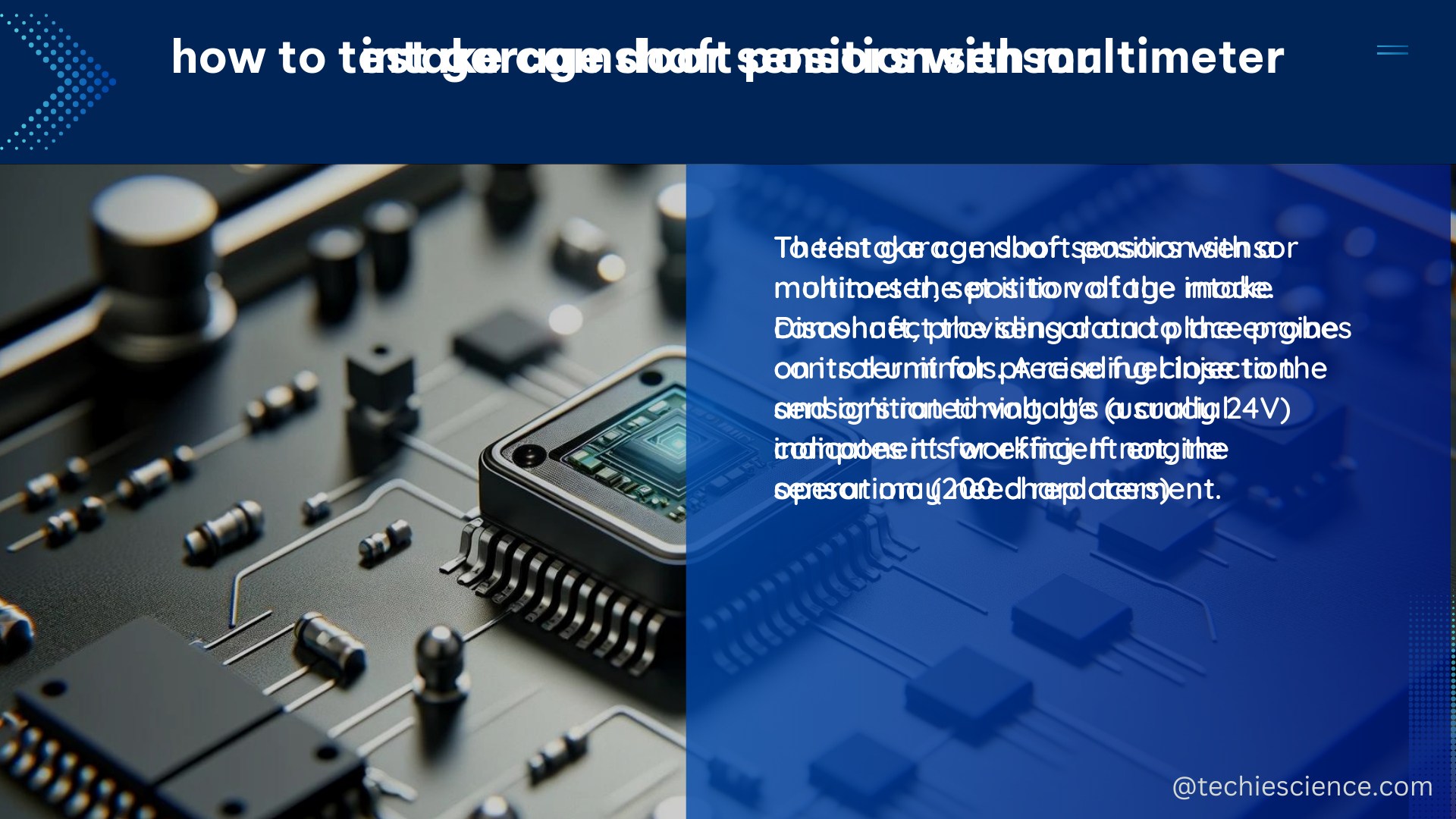The intake camshaft position sensor is a critical component in modern engines, responsible for providing precise timing information to the engine control unit (ECU) for optimal engine performance. This sensor is typically located near the intake camshaft, often behind the intake manifold, and can be accessed by removing the intake manifold.
Understanding the Intake Camshaft Position Sensor
The intake camshaft position sensor is a Hall-effect sensor that monitors the position of the intake camshaft. It sends a signal to the ECU, which uses this information to precisely control the timing of the fuel injection and ignition systems. This ensures that the engine operates at peak efficiency, delivering optimal power, fuel economy, and emissions.
Sensor Construction and Operation
The intake camshaft position sensor consists of a permanent magnet and a Hall-effect integrated circuit. As the camshaft rotates, the sensor detects the changes in the magnetic field, which are then converted into a digital signal. This signal is sent to the ECU, which uses it to determine the position and timing of the intake valves.
The sensor is typically mounted in a housing that is secured to the engine block or cylinder head, with the sensor tip positioned near the camshaft. The sensor’s output signal is a series of pulses, with the frequency and timing of these pulses corresponding to the camshaft’s rotational speed and position.
Sensor Specifications
The intake camshaft position sensor must meet strict specifications to ensure reliable operation. Some key specifications include:
- Voltage range: Typically 5-12 volts DC
- Output signal: Square wave or sinusoidal
- Frequency range: Dependent on engine speed, typically up to 10 kHz
- Operating temperature range: -40°C to 125°C (-40°F to 257°F)
- Resistance: Typically 1-10 kΩ
It is essential to use a replacement sensor that meets or exceeds the original equipment manufacturer’s (OEM) specifications to ensure proper engine operation and avoid potential issues.
Symptoms of a Failing Intake Camshaft Position Sensor

When the intake camshaft position sensor begins to fail, it can exhibit various symptoms that may indicate a problem. These include:
- Occasional backfiring or popping
- Flashing of the service engine soon (SES) light
- Intermittent issues with engine performance, such as hesitation or stumbling upon acceleration
- Hard starts and reduced fuel economy
- Engine entering “batch fire” mode, where all injectors on one bank are sprayed simultaneously
It’s important to note that a failing camshaft position sensor may not always trigger a check engine light or cause the engine to shut down completely, making it challenging to diagnose without a thorough inspection.
Diagnosing and Replacing the Intake Camshaft Position Sensor
To diagnose and replace the intake camshaft position sensor, follow these steps:
- Inspect the Sensor and Wiring: Visually inspect the sensor for any signs of damage, such as cracks, scratches, or corrosion. Check the wiring for any issues, such as pinches, burns, or loose connections.
- Check the Sensor Signal: Use a multimeter to measure the sensor’s output signal. Refer to the manufacturer’s specifications to ensure the signal is within the expected range.
- Access the Sensor: Typically, the intake camshaft position sensor is secured by a single bolt and can be accessed by removing the intake manifold.
- Replace the Sensor: Carefully remove the old sensor and install the new one, ensuring it is properly aligned and tightened. Reconnect the wiring and ensure a secure connection.
- Clear Diagnostic Codes: After replacing the sensor, clear any diagnostic trouble codes that may have been set and perform a test drive to ensure proper engine operation.
In some cases, it may be beneficial to replace both the intake and exhaust camshaft position sensors as a precautionary measure, even if only one is failing, to ensure optimal engine performance and prevent future issues.
Importance of Proper Sensor Handling
The intake camshaft position sensor is a sensitive component, and any marks or imperfections on its surface can prevent it from functioning correctly. It is essential to handle the sensor with care during installation and replacement to avoid damage.
When handling the sensor, be sure to:
- Avoid touching the sensor’s surface with bare hands, as oils and contaminants can interfere with its operation.
- Use clean, lint-free gloves or tools to handle the sensor.
- Protect the sensor from any impacts or vibrations that could cause damage.
- Ensure the sensor is properly aligned and tightened to the specified torque.
Proper handling and installation of the intake camshaft position sensor are crucial for maintaining optimal engine performance and preventing future issues.
Conclusion
The intake camshaft position sensor is a critical component in modern engines, responsible for providing precise timing information to the ECU. When this sensor begins to fail, it can exhibit various symptoms, including engine performance issues and reduced fuel economy.
Diagnosing and replacing the intake camshaft position sensor requires a thorough inspection, signal testing, and careful handling during the replacement process. By understanding the sensor’s construction, operation, and proper handling techniques, you can ensure your engine operates at peak efficiency and avoid potential issues down the road.
Remember, always refer to the manufacturer’s specifications and guidelines when working with the intake camshaft position sensor to ensure a successful repair and maintain optimal engine performance.
Reference:
– Evolution M – Intake Exhaust Cam Position Sensor Same Part?
– LS1Tech – What are the signs of a failing camshaft position sensor?
– MB World – Intake Camshaft Position Sensor Fault
– Club Lexus – Code P0345 Camshaft Sensor

The lambdageeks.com Core SME Team is a group of experienced subject matter experts from diverse scientific and technical fields including Physics, Chemistry, Technology,Electronics & Electrical Engineering, Automotive, Mechanical Engineering. Our team collaborates to create high-quality, well-researched articles on a wide range of science and technology topics for the lambdageeks.com website.
All Our Senior SME are having more than 7 Years of experience in the respective fields . They are either Working Industry Professionals or assocaited With different Universities. Refer Our Authors Page to get to know About our Core SMEs.